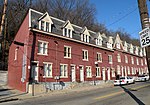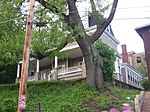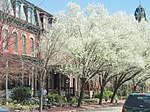Union Dale Cemetery, Pittsburgh
1846 establishments in PennsylvaniaCemeteries in Pittsburgh

Union Dale Cemetery is a cemetery at 2200 Brighton Road, in Pittsburgh, Allegheny County, Pennsylvania. The cemetery is divided into three parts: Division 1 (north side), east of Brighton Road and north of Marshall Avenue; Division 2 (south side), east of Brighton Road and south of Marshall Avenue; Division 3 (west side), west of Brighton Road and south of Island Avenue. Divisions 1 and 2 are part of the Perry Hilltop neighborhood, and Division 3 is in the California-Kirkbride neighborhood, with Brighton Road the border between the neighborhoods.
Excerpt from the Wikipedia article Union Dale Cemetery, Pittsburgh (License: CC BY-SA 3.0, Authors, Images).Union Dale Cemetery, Pittsburgh
Brighton Road, Pittsburgh
Geographical coordinates (GPS) Address Nearby Places Show on map
Geographical coordinates (GPS)
| Latitude | Longitude |
|---|---|
| N 40.463638 ° | E -80.02151 ° |
Address
Brighton Road 2200
15214 Pittsburgh
Pennsylvania, United States
Open on Google Maps









